Perovskite versus ZnCuInS/ZnS Luminescent Nanoparticles in Wavelength-Shifting Layers for Sensor Applications
Abstract
:1. Introduction
- Metal oxides such as zinc oxide (ZnO) and titanium dioxide (TiO2) have an energy bandgap corresponding to the UV range absorption (3.37 eV for ZnO, 3.2 eV for TiO2 anatase and 3.0eV for TiO2 rutile [7]). Thanks to the defect-related states, the emission in the visible range can be observed [8,9,10]. While doping them with different metals, an increase in the PLQY can be observed. For example, for lightly S-doped ZnO powder, an efficiency of 55% has been reported, increasing up to 75% at higher doping concentration [11]. Another approach is taking advantage of miniaturization. The defect states of metal oxide nanoparticles can be controlled by the synthesis method. Recently, ZnO/polyacrylic acid (PAA) nanohybrids in silica coating of PLQY of 64% have been reported [12].
- Metal oxides doped with rare earth ions, in which the origin of photoluminescence is the intraband 4f-4f transitions as well as 4f-5d interband transitions [13,14]. They are the state-of-the-art phosphors researched for application in white LEDs and can achieve PLQY close to 80–90% with satisfactory excitation–emission characteristics [15]. Among this group, the best known persistent luminescent phosphors can be found with afterglow of several hours [16]. Their application in luminescent solar concentrators for photovoltaics has been widely researched [17,18,19] also by the authors [20]. For enhancing the real-time photoresponse of photodetectors, the types with the shortest possible photoluminescence lifetime should be considered.
- State-of-the-art quantum dots of different kinds. Among all types of nanostructures, quantum dots possess the highest density of states and therefore can exhibit high luminescence efficiency close to 100% [21]. Especially desirable for the considered application, they also possess very narrow emission spectra, which can be tailored by their size. Cd-based QDs are probably the most researched luminescent nanomaterial thanks to their ease of synthesis and suitable optical properties [17]. Another widely researched wavelength-shifting material is Pb-based QDs. Moreover, all-inorganic lead halide perovskite QDs (IPSK QDs) have emerged as attractive candidates for wavelength-shifting agents due to their controllable and high-intensity PL, high optical absorption coefficient [10], high chemical stability and single-component ultra-fast decay time of the order of ns at room temperature [22]. Their successful application as wavelength-shifting agents has been proven, among others, in photovoltaics [23,24] and high-energy physics [25]. Despite the excellent optical properties of Pb- and Cd-based materials, their application on a large scale is unlikely due to the toxicity of lead and cadmium. The best available heavy-metal free quantum dots are based on ZnS, ZnSe, InP, Si, CuInS2 and, recently popular due to their high abundance, low toxicity and large possibility of tailoring the bandgap, graphene and carbon QDs. For ZnSe QDs, a PL efficiency equal to 70% has been reported [26], and for carbon QDs, the achieved efficiency is as high as 94% [27]. ZnCuInS/ZnS core-shell QDs, which are considered in the frame of this article, are hydrophobic quantum dots [28] exhibiting tunable emission in the visible spectral window from around 500 to 620 nm [29] and PLQY up to 81% [30].
2. Materials and Methods
3. Results
3.1. Characterization of the Wavelength-Shifting Agents
3.2. Wavelength-Shifting Layers
- 240 nm, at which a local minimum can be observed in some samples.
- UV-B and UV-A range, where a stable and slight enhancement (up to 2–3%) of the transmittance is observed. The wavelength range 270–500 nm corresponds to the excitation region of the measured quantum dots.
4. Discussion
- Absorbance of the luminescent material is approximated by the excitation spectrum, as shown in Figure 5. The maximum absorbance is set to 1. This approximation is based on the absorption measurement, which demonstrated that the absorption and excitation spectra correlated with each other.
- Transmittance is equal to . For the wavelengths where there is no absorption, the transmittance is set to 1. This assumption is used due to the fact that the transmittance measured for coatings is in fact modified by the wavelength-shifting effect. Reflectance and scattering are excluded from this model, as it is based only on the experimental measurements of the luminescent materials and not on the deposited coatings.
- The shape of the emission spectrum is invariant with the excitation wavelength; therefore, the integral is constant for a particular luminescent material and a particular detector type. This is supported by the excitation–emission measurements.
- The PLQY is set to 10% in order to compensate all the “optimistic” assumptions described in the previous points as well as to “smooth” the curves presented in Figure 18.
5. Conclusions
Supplementary Materials
Author Contributions
Funding
Institutional Review Board Statement
Informed Consent Statement
Data Availability Statement
Conflicts of Interest
References
- OSI Optoelectronics Catalogue. Available online: http://www.osioptoelectronics.com/Libraries/Datasheets/UV-Enhanced-Inversion-Layer-Photodiodes.sflb.ashx (accessed on 10 December 2020).
- Hamamatsu Multi Pixel Photon Counter Technical note. Available online: https://www.hamamatsu.com/resources/pdf/ssd/s13360_series_kapd1052e.pdf (accessed on 15 December 2020).
- Si Photodiodes Technical note. Available online: https://www.hamamatsu.com/resources/pdf/ssd/s1227_series_kspd1036e.pdf (accessed on 15 December 2020).
- Son, J. UV detectors: Status and prospects. In Proceedings of the UV and Higher Energy Photonics: From Materials to Applications 2018, San Diego, CA, USA, 19–20 August 2018; p. 107270F. [Google Scholar]
- Álvarez, V.; Agramunt, J.; Ball, M.; Batallé, M.; Bayarri, J.; Borges, F.I.G.; Bolink, H.; Brine, H.; Cárcel, S.; Carmona, J.M.; et al. SiPMs coated with TPB: Coating protocol and characterization for NEXT. J. Instrum. 2012, 7, P02010. [Google Scholar] [CrossRef]
- Sahi, S.; Magill, S.; Ma, L.; Xie, J.; Chen, W.; Jones, B.; Nygren, D. Wavelength-shifting properties of luminescence nanoparticles for high energy particle detection and specific physics process observation. Sci. Rep. 2018, 8, 1–9. [Google Scholar] [CrossRef] [PubMed]
- Sosna-Głębska, A.; Szczecińska, N.; Znajdek, K.; Sibiński, M. Review on metallic oxide nanoparticles and their application in optoelectronic devices. Acta Innov. 2019, 30, 5–15. [Google Scholar] [CrossRef]
- Szczecińska, N.; Znajdek, K.; Sosna-Głębska, A.; Lewicki, P.; Czarnecki, P.; Kraska, P.; Bazdyga, C.; Wiosna-Sałyga, G.; Sibiński, M. The photoluminescent layers based on ZnO nanoparticles as radiation converters in photovoltaic applications. Acta Innov. 2018, 29, 16–26. [Google Scholar] [CrossRef]
- Kumar, V.; Ntwaeaborwa, O.M.; Soga, T.; Dutta, V.; Swart, H.C. Rare Earth Doped Zinc Oxide Nanophosphor Powder: A Future Material for Solid State Lighting and Solar Cells. ACS Photonics 2017, 4, 2613–2637. [Google Scholar] [CrossRef]
- Znajdek, K.; Sibiński, M.; Lisik, Z.; Apostoluk, A.; Zhu, Y.; Masenelli, B.; Sędzicki, P. Zinc oxide nanoparticles for improvement of thin film photovoltaic structures’ efficiency through down shifting conversion. Opto Electron. Rev. 2017, 25, 99–102. [Google Scholar] [CrossRef]
- Foreman, J.V.; Everitt, H.O.; Yang, J.; Liu, J. Influence of temperature and photoexcitation density on the quantum efficiency of defect emission in ZnO powders. Appl. Phys. Lett. 2007, 91, 11902. [Google Scholar] [CrossRef] [Green Version]
- Zhang, Y.; Gard, T.; Theron, C.; Apostoluk, A.; Masenelli-Varlot, K.; Canut, B.; Daniele, S.; Masenelli, B. Visible luminescence improvement of ZnO/PAA nano-hybrids by silica coating. Appl. Surf. Sci. 2021, 540, 148343. [Google Scholar] [CrossRef]
- Zhydachevskyy, Y.; Syvorotka, I.; Tsiumra, V.; Baran, M.; Lipińska, L.; Wierzbicka, A.; Suchocki, A. Quantum efficiency of the down-conversion process in Bi3+–Yb3+ and Ce3+–Yb3+ co-doped garnets. Sol. Energy Mater. Sol. Cells 2018, 185, 240–251. [Google Scholar] [CrossRef]
- Correia, S.F.H.; Bermudez, V.D.Z.; Ribeiro, S.J.L.; André, P.S.; Ferreira, R.A.S.; Carlos, L.D. Luminescent solar concentrators: Challenges for lanthanide-based organic–inorganic hybrid materials. J. Mater. Chem. A 2014, 2, 5580–5596. [Google Scholar] [CrossRef]
- de la Mora, M.B.; Amelines-Sarria, O.; Monroy, B.M.; Hernández-Pérez, C.D.; Lugo, J.E. Materials for downconversion in solar cells: Perspectives and challenges. Sol. Energy Mater. Sol. Cells 2017, 165, 59–71. [Google Scholar] [CrossRef]
- Botterman, J.; Joos, J.J.; Smet, P.F. Trapping and detrapping in SrAl2 O4:Eu,Dy persistent phosphors: Influence of excitation wavelength and temperature. Phys. Rev. B Condens. Matter Mater. Phys. 2014, 90, 085147. [Google Scholar] [CrossRef] [Green Version]
- Mazzaro, R.; Vomiero, A. The Renaissance of Luminescent Solar Concentrators: The Role of Inorganic Nanomaterials. Adv. Energy Mater. 2018, 8, 1801903. [Google Scholar] [CrossRef]
- Wilson, L.R.; Rowan, B.C.; Robertson, N.; Moudam, O.; Jones, A.C.; Richards, B.S. Characterization and reduction of reabsorption losses in luminescent solar concentrators. Appl. Opt. 2010, 49, 1651–1661. [Google Scholar] [CrossRef] [PubMed] [Green Version]
- Wang, T.; Zhang, J.; Ma, W.; Luo, Y.; Wang, L.; Hu, Z.; Wu, W.; Wang, X.; Zou, G.; Zhang, Q. Luminescent solar concentrator employing rare earth complex with zero self-absorption loss. Sol. Energy 2011, 85, 2571–2579. [Google Scholar] [CrossRef]
- Znajdek, K.; Szczecińska, N.; Sibiński, M.; Wiosna-Sałyga, G.; Przymęcki, K. Luminescent layers based on rare earth elements for thin-film flexible solar cells applications. Optik 2018, 165, 200–209. [Google Scholar] [CrossRef]
- Alivisatos, A.P. Semiconductor Clusters, Nanocrystals, and Quantum Dots. Science 1996, 271, 933–937. [Google Scholar] [CrossRef] [Green Version]
- Sadhanala, A.; Ahmad, S.; Zhao, B.; Giesbrecht, N.; Pearce, P.M.; Deschler, F.A.; Hoye, R.L.Z.; Gödel, K.C.; Bein, T.; Docampo, P.; et al. Blue-Green Color Tunable Solution Processable Organolead Chloride–Bromide Mixed Halide Perovskites for Optoelectronic Applications. Nano Lett. 2015, 15, 6095–6101. [Google Scholar] [CrossRef] [Green Version]
- Cao, Y.; Wu, D.; Zhu, P.; Shan, D.; Zeng, X.; Xu, J. Down-shifting and anti-reflection effect of CsPbBr3 quantum dots/multicrystalline silicon hybrid structures for enhanced photovoltaic properties. Nanomaterials 2020, 10, 775. [Google Scholar] [CrossRef] [PubMed]
- Meng, L.; Shi, L.; Ge, Y.; Tang, J.; Chen, Y.; Zhong, H. Photon management of combining nanostructural antireflection and perovskite down-shifting composite films for improving the efficiency of silicon solar cells. Sol. Energy Mater. Sol. Cells 2021, 220, 110856. [Google Scholar] [CrossRef]
- Datta, A.; Barman, B.; Magill, S.; Motakef, S. Highly efficient photon detection systems for noble liquid detectors based on perovskite quantum dots. Sci. Rep. 2020, 10, 1–11. [Google Scholar] [CrossRef]
- Xu, G.; Li, Y.; Qin, Y.; Liu, Z.; Han, J.; Han, Y.; Yao, K. Fabrication and enhanced optical properties of ZnSe:Mn quantum dots/poly(LMA-co-EGDMA) composite thin film by alkylthiol modification. Opt. Mater. Express 2015, 5, 1460–1468. [Google Scholar] [CrossRef]
- Hola, K.; Zhang, Y.; Wang, Y.; Giannelis, E.P.; Zboril, R.; Rogach, A.L. Carbon dots—Emerging light emitters for bioimaging, cancer therapy and optoelectronics. Nano Today 2014, 9, 590–603. [Google Scholar] [CrossRef]
- Saatsakis, G.; Kalyvas, N.; Michail, C.; Ninos, K.; Bakas, A.; Fountzoula, C.; Sianoudis, I.; Karpetas, G.E.; Fountos, G.; Kandarakis, I.; et al. Optical Characteristics of ZnCuInS/ZnS (Core/Shell) Nanocrystal Flexible Films Under X-Ray Excitation. Crystals 2019, 9, 343. [Google Scholar] [CrossRef] [Green Version]
- Jia, Y.; Wang, H.; Xiang, L.; Liu, X.; Wei, W.; Ma, N.; Sun, D. Tunable emission properties of core-shell ZnCuInS-ZnS quantum dots with enhanced fluorescence intensity. J. Mater. Sci. Technol. 2018, 34, 942–948. [Google Scholar] [CrossRef]
- Meinardi, F.; McDaniel, H.; Carulli, F.; Colombo, A.; Velizhanin, K.A.; Makarov, N.S.; Simonutti, R.; Klimov, V.I.; Brovelli, S. Highly efficient large-area colourless luminescent solar concentrators using heavy-metal-free colloidal quantum dots. Nat. Nanotechnol. 2015, 10, 878–885. [Google Scholar] [CrossRef] [PubMed]
- Shin, J.Y.; Park, J.Y.; Liu, C.; He, J.; Kim, S.C. Chemical structure and physical properties of cyclic olefin copolymers (IUPAC Technical Report). Pure Appl. Chem. 2005, 77, 801–814. [Google Scholar] [CrossRef]
- Kang, C.H.; Dursun, I.; Liu, G.; Sinatra, L.; Sun, X.; Kong, M.; Pan, J.; Maity, P.; Ooi, E.-N.; Ng, T.K.; et al. High-speed colour-converting photodetector with all-inorganic CsPbBr3 perovskite nanocrystals for ultraviolet light communication. Light Sci. Appl. 2019, 8, 94. [Google Scholar] [CrossRef]
- Kalytchuk, S.; Zdražil, L.; Scheibe, M.; Zbořil, R. Purple-emissive carbon dots enhance sensitivity of Si photodetectors to ultraviolet range. Nanoscale 2020, 12, 8379–8384. [Google Scholar] [CrossRef]
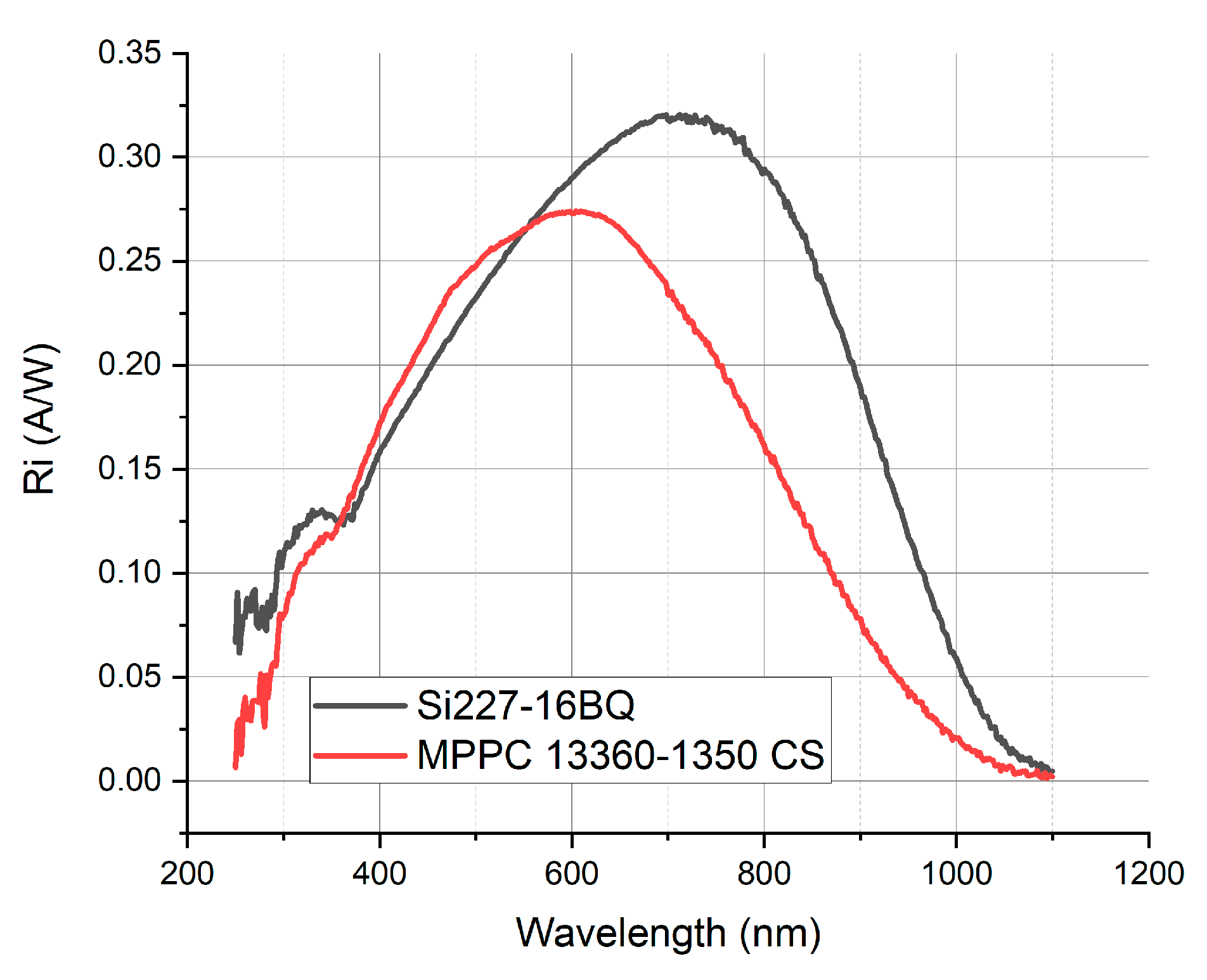

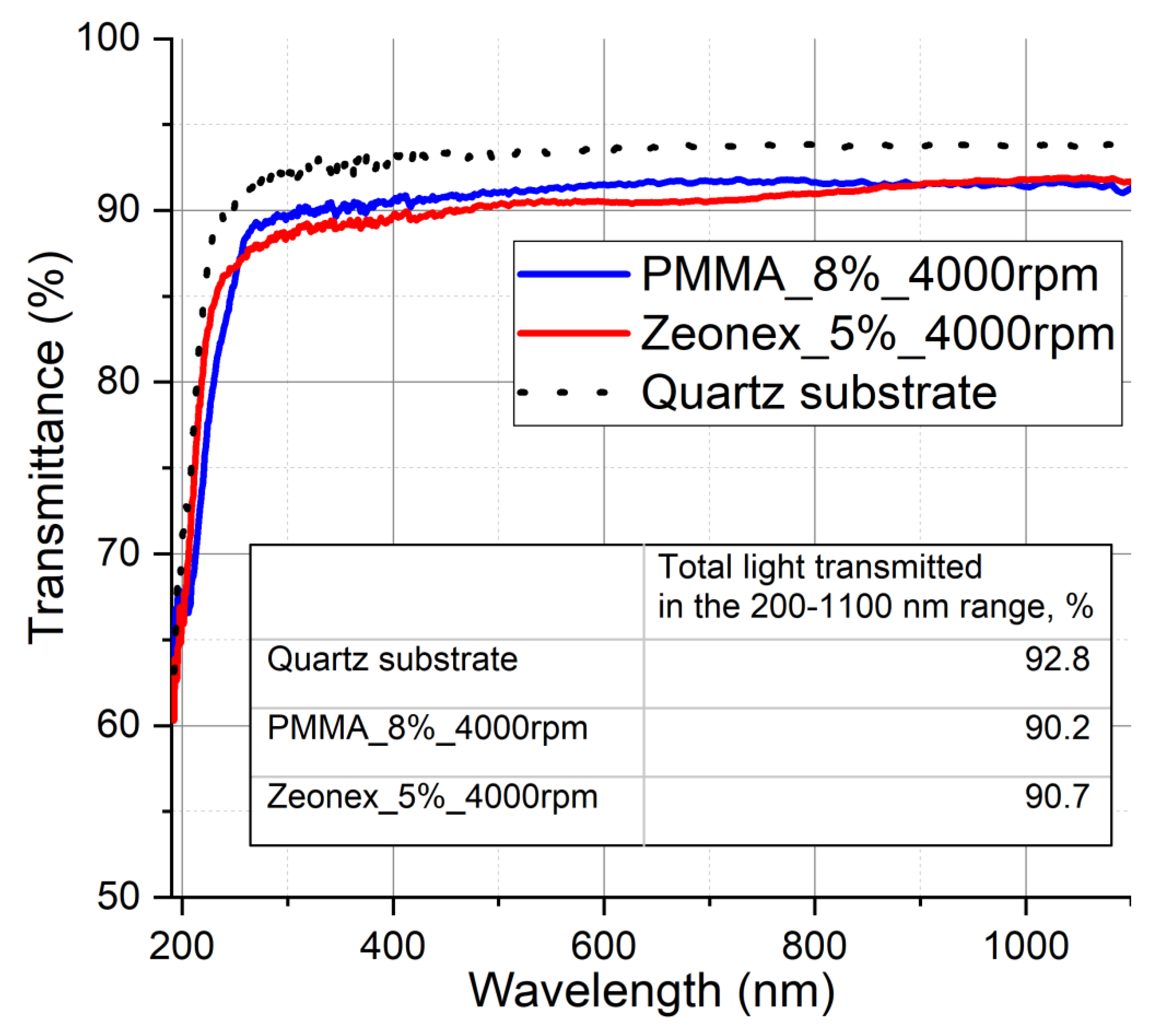

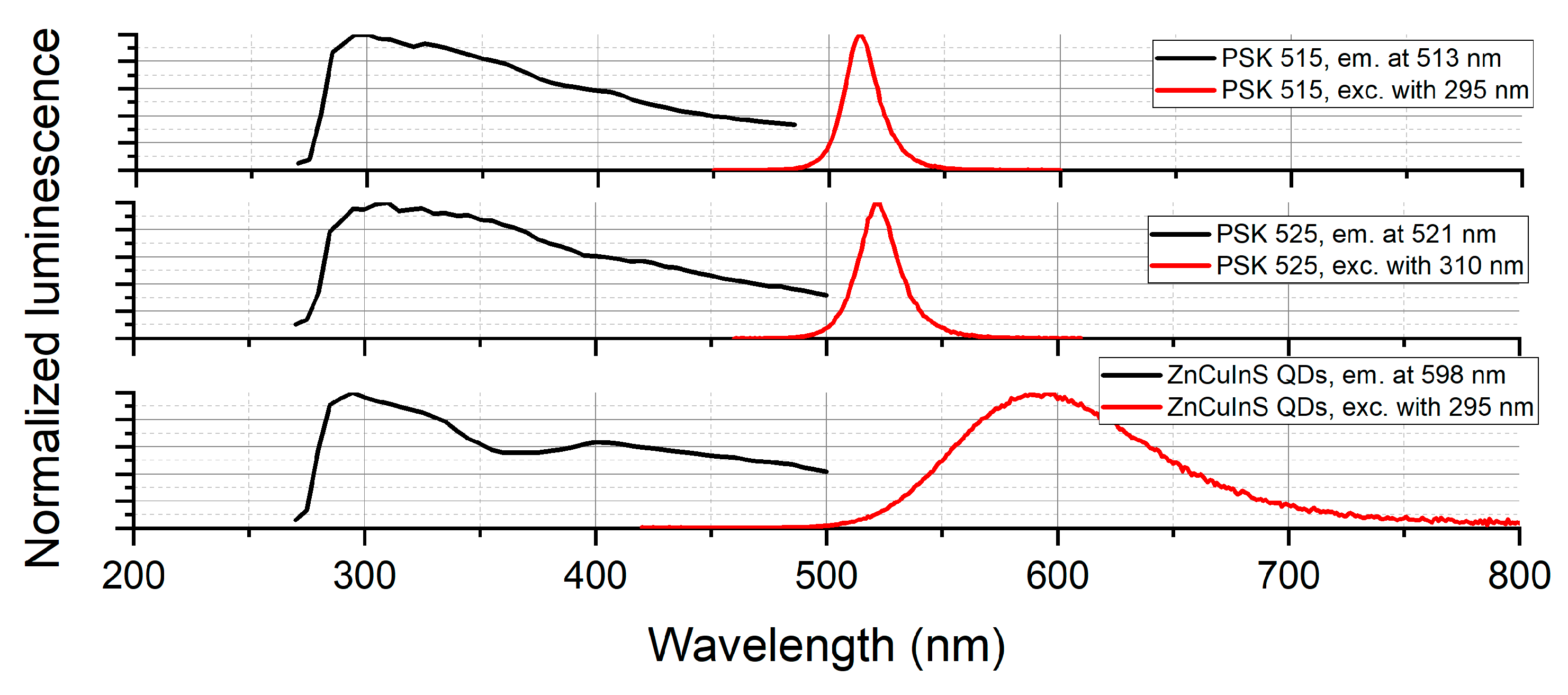

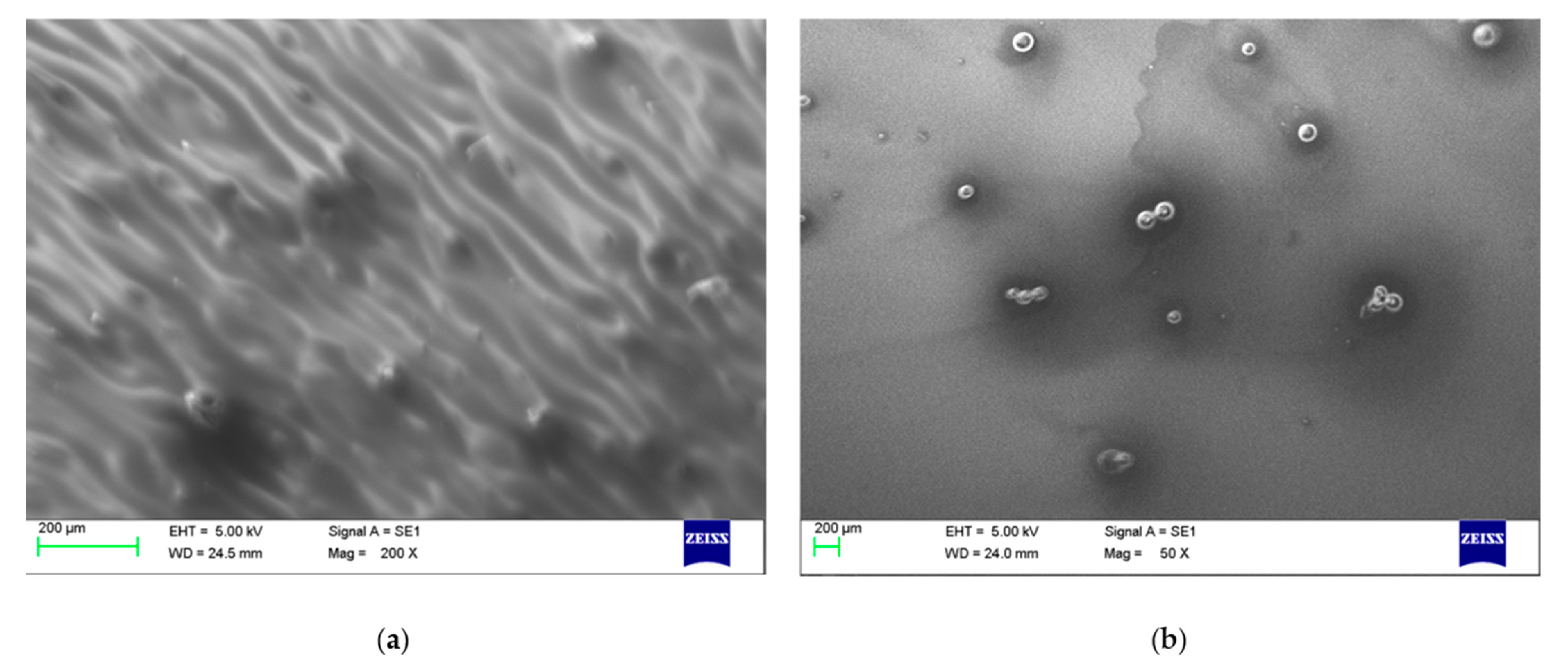
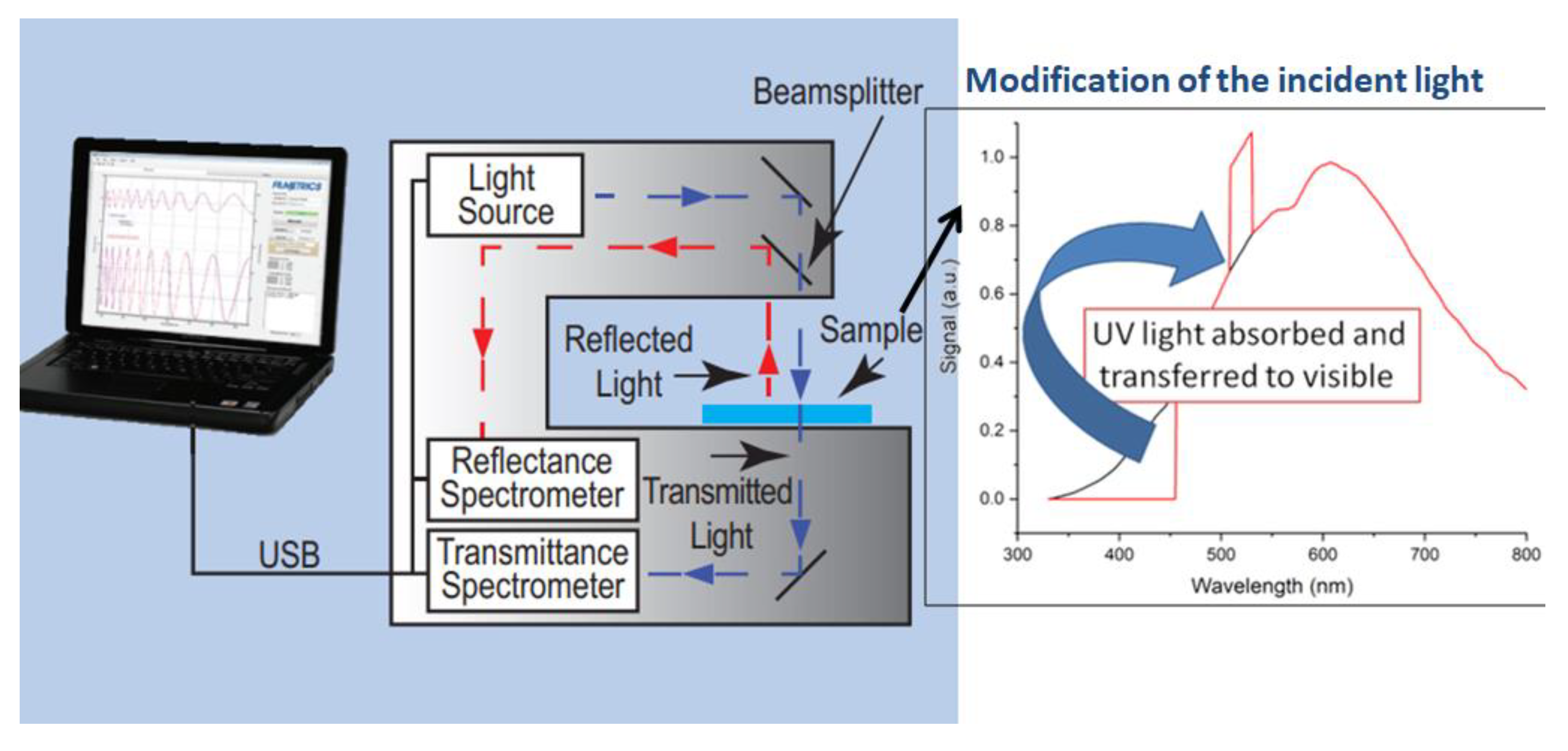
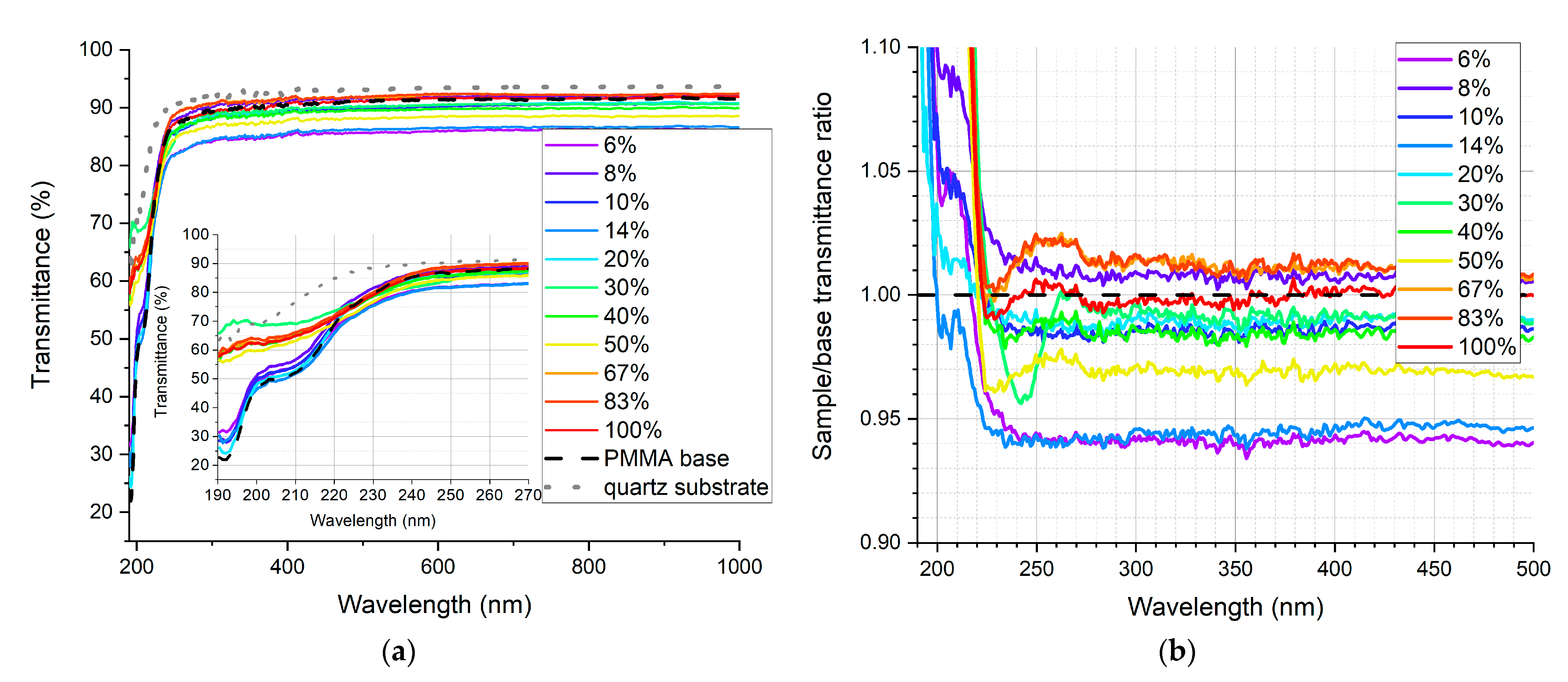
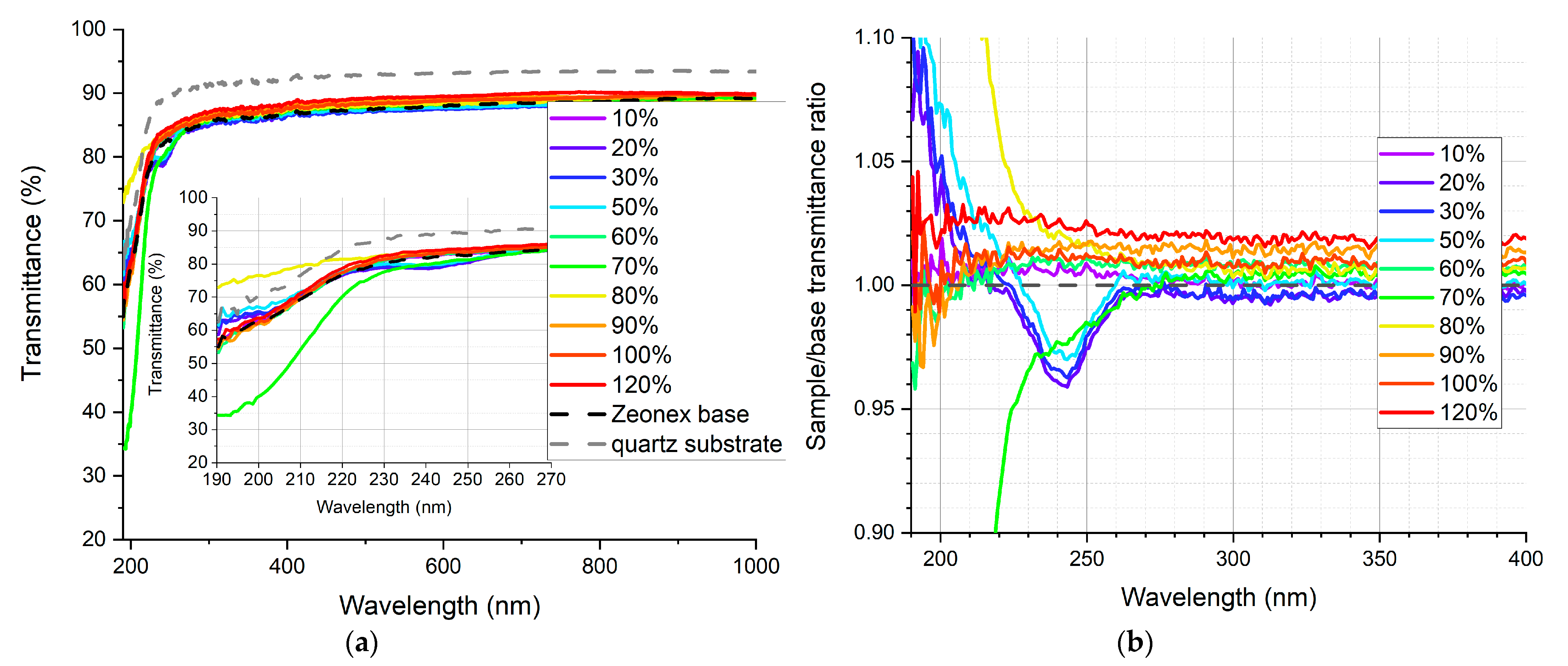



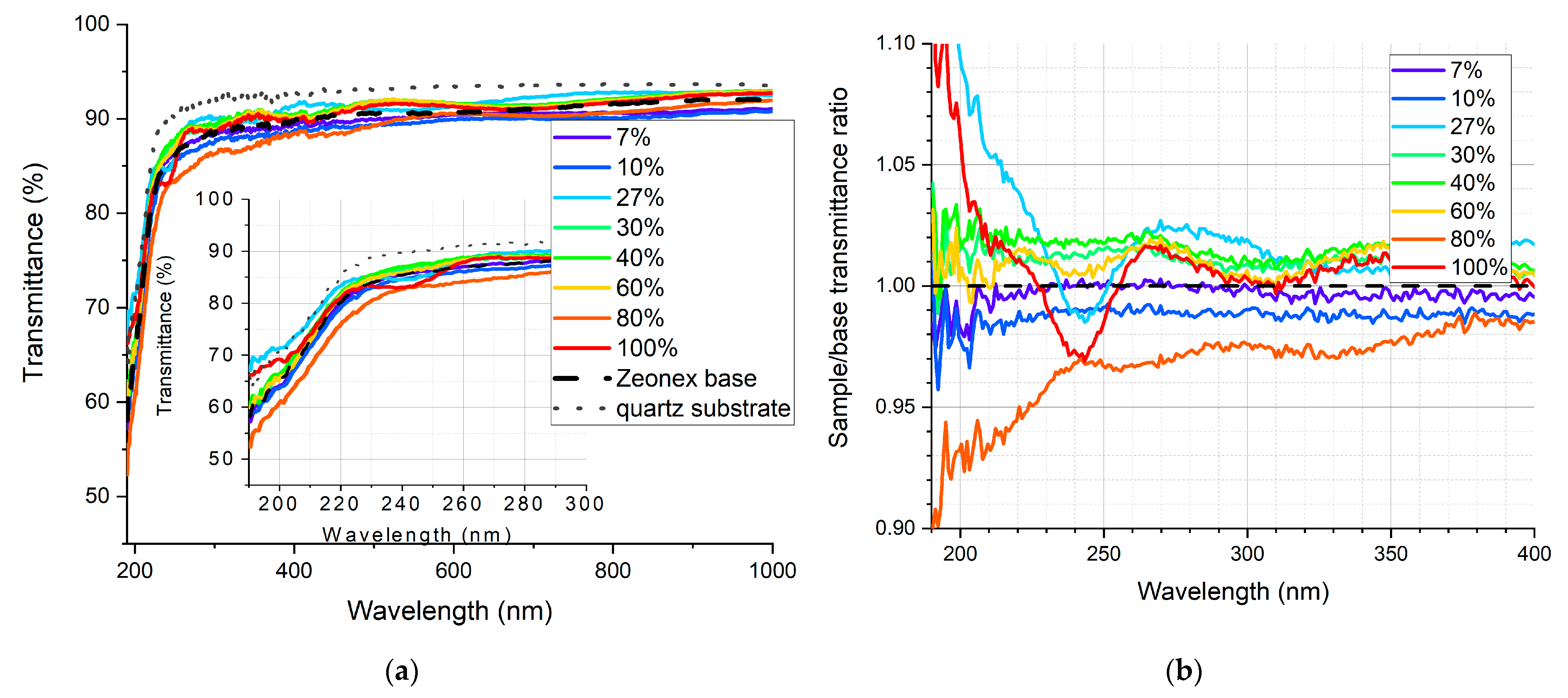

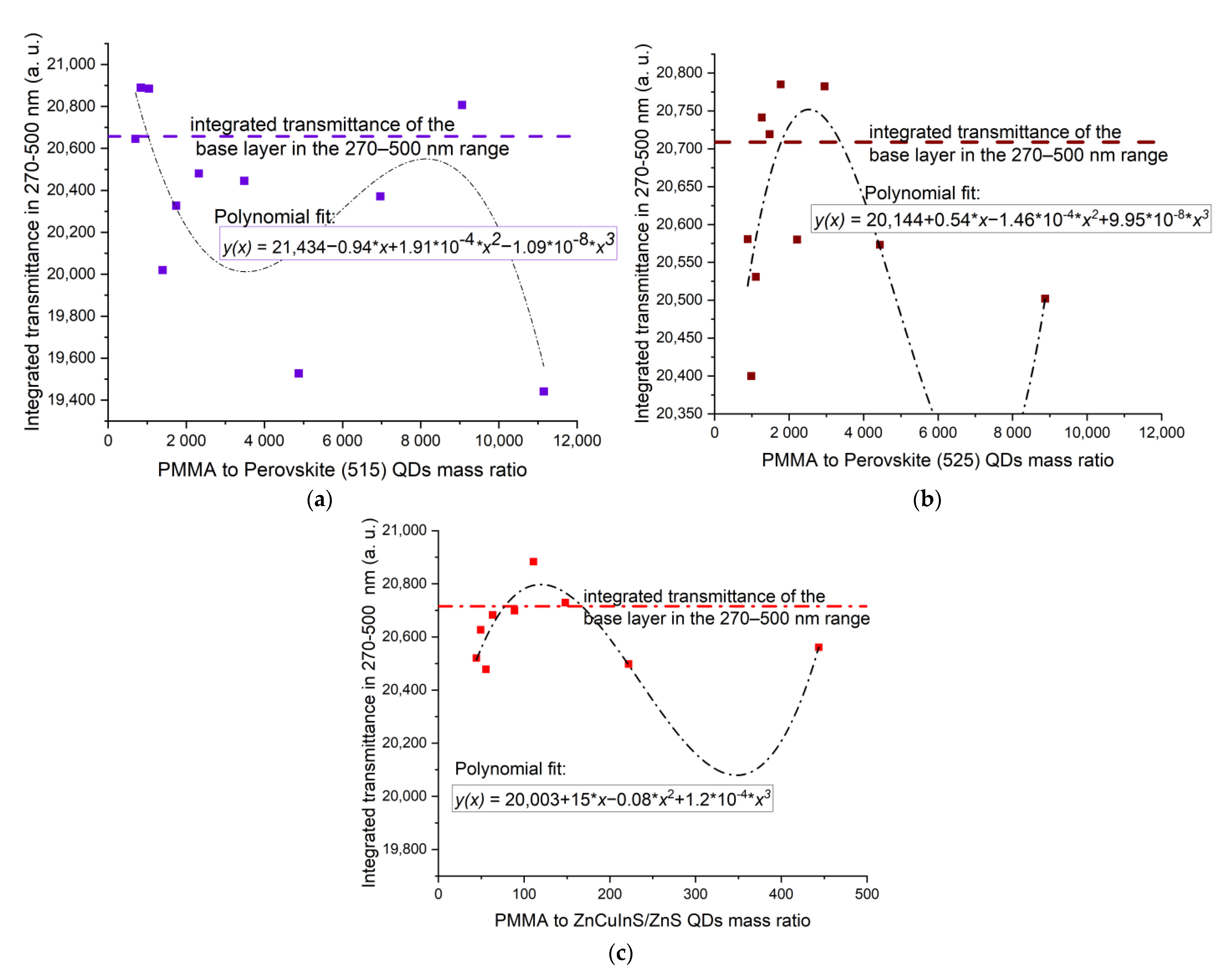

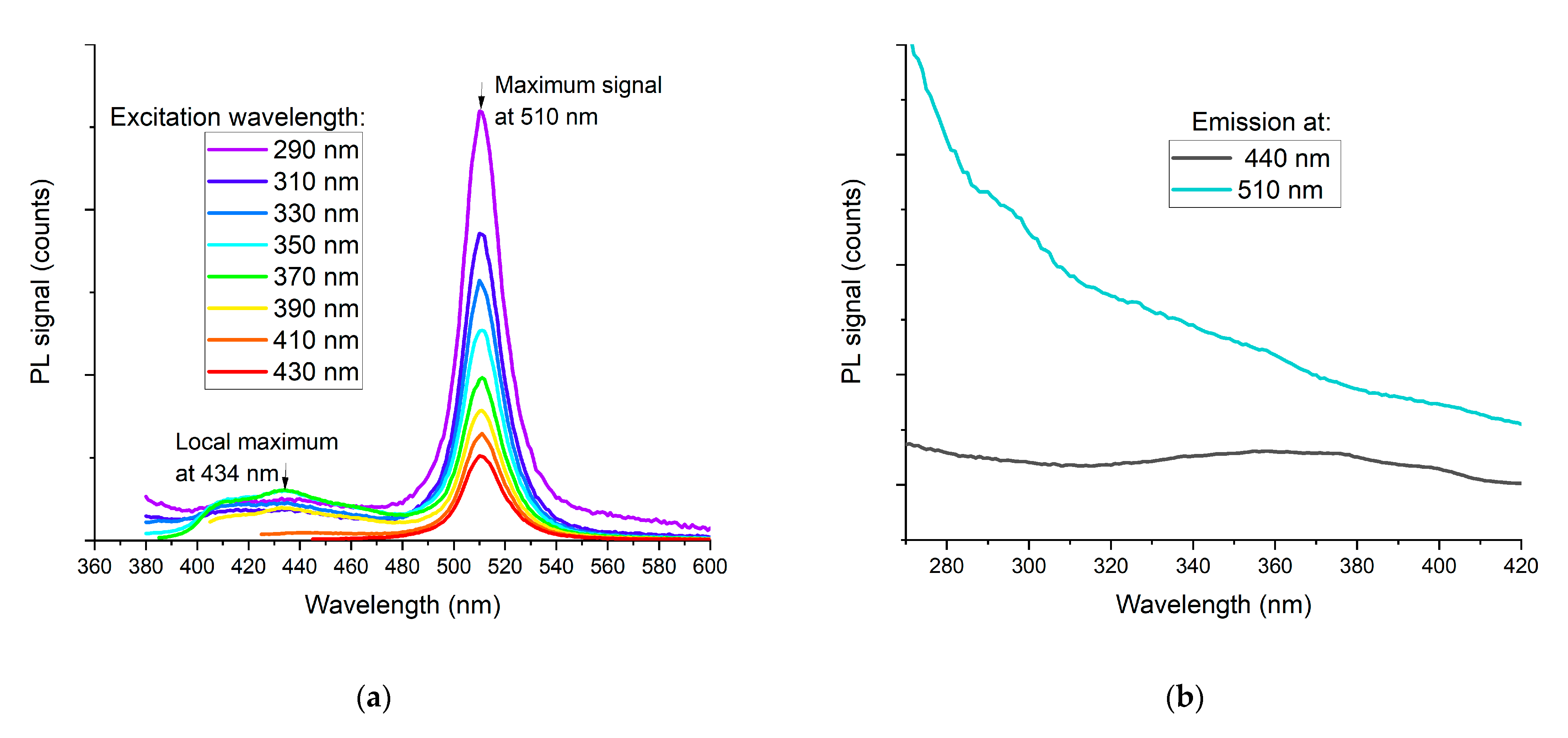

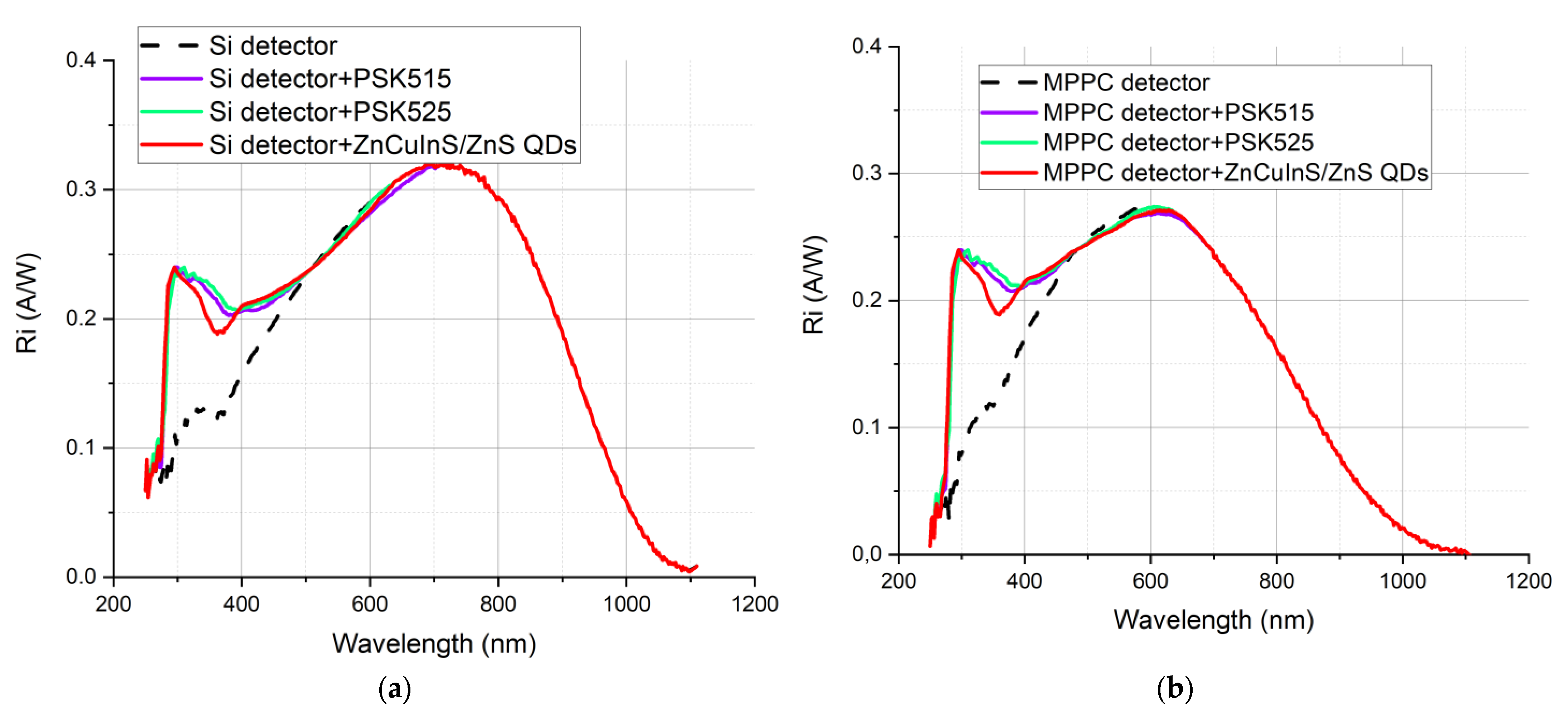
| Short Name | Composition | Average Particle Size (Producer Data) | Photoluminescence Quantum Yield (Producer Data) | Excitation Range | Maximum Emission | FWHM of Emission Peak |
|---|---|---|---|---|---|---|
| PSK QDs 515 | CsPbBr3 | ~10 nm | ~90% | 270–500 nm | 513 nm | 16.5 nm |
| PSK QDs 525 | CsPb(I/Br)3 | 521 nm | 21.5 nm | |||
| ZnCuInS QDs | Zn-Cu-In-S/ZnS | 4–5 nm | 15–30% | 598 nm | 98 nm |
Publisher’s Note: MDPI stays neutral with regard to jurisdictional claims in published maps and institutional affiliations. |
© 2021 by the authors. Licensee MDPI, Basel, Switzerland. This article is an open access article distributed under the terms and conditions of the Creative Commons Attribution (CC BY) license (https://creativecommons.org/licenses/by/4.0/).
Share and Cite
Sosna-Głębska, A.; Szczecińska, N.; Sibiński, M.; Wiosna-Sałyga, G.; Januszewicz, B. Perovskite versus ZnCuInS/ZnS Luminescent Nanoparticles in Wavelength-Shifting Layers for Sensor Applications. Sensors 2021, 21, 3165. https://doi.org/10.3390/s21093165
Sosna-Głębska A, Szczecińska N, Sibiński M, Wiosna-Sałyga G, Januszewicz B. Perovskite versus ZnCuInS/ZnS Luminescent Nanoparticles in Wavelength-Shifting Layers for Sensor Applications. Sensors. 2021; 21(9):3165. https://doi.org/10.3390/s21093165
Chicago/Turabian StyleSosna-Głębska, Aleksandra, Natalia Szczecińska, Maciej Sibiński, Gabriela Wiosna-Sałyga, and Bartłomiej Januszewicz. 2021. "Perovskite versus ZnCuInS/ZnS Luminescent Nanoparticles in Wavelength-Shifting Layers for Sensor Applications" Sensors 21, no. 9: 3165. https://doi.org/10.3390/s21093165
APA StyleSosna-Głębska, A., Szczecińska, N., Sibiński, M., Wiosna-Sałyga, G., & Januszewicz, B. (2021). Perovskite versus ZnCuInS/ZnS Luminescent Nanoparticles in Wavelength-Shifting Layers for Sensor Applications. Sensors, 21(9), 3165. https://doi.org/10.3390/s21093165







